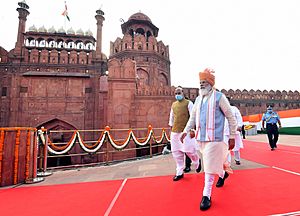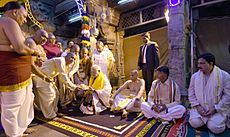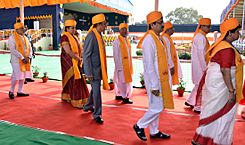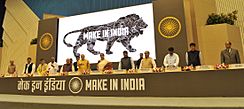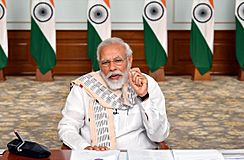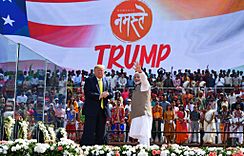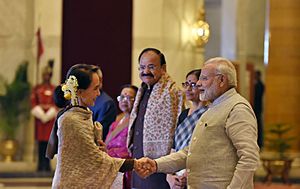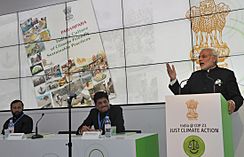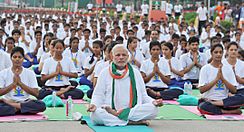Narendra Modi facts for kids
Quick facts for kids
Narendra Modi
|
|||||||||||||
|---|---|---|---|---|---|---|---|---|---|---|---|---|---|

Official portrait, 2023
|
|||||||||||||
| Prime Minister of India | |||||||||||||
| Assumed office 26 May 2014 |
|||||||||||||
| President | Pranab Mukherjee Ram Nath Kovind Droupadi Murmu |
||||||||||||
| Vice President | Mohammad Hamid Ansari Venkaiah Naidu Jagdeep Dhankhar |
||||||||||||
| Preceded by | Manmohan Singh | ||||||||||||
|
|||||||||||||
| Leader of the House, Lok Sabha | |||||||||||||
| Assumed office 26 May 2014 |
|||||||||||||
| Deputy | Gopinath Munde Sushma Swaraj Rajnath Singh Nitin Gadkari |
||||||||||||
| Speaker | Sumitra Mahajan Om Birla |
||||||||||||
| Preceded by | Sushilkumar Shinde | ||||||||||||
| Member of Parliament, Lok Sabha | |||||||||||||
| Assumed office 5 June 2014 |
|||||||||||||
| Preceded by | Murli Manohar Joshi | ||||||||||||
| Constituency | Varanasi, Uttar Pradesh | ||||||||||||
| Chief Minister of Gujarat | |||||||||||||
| In office 7 October 2001 – 22 May 2014 |
|||||||||||||
| Governor |
List
|
||||||||||||
| Preceded by | Keshubhai Patel | ||||||||||||
| Succeeded by | Anandiben Patel | ||||||||||||
| Member of Gujarat Legislative Assembly | |||||||||||||
| In office 15 December 2002 – 16 May 2014 |
|||||||||||||
| Preceded by | Kamlesh Patel | ||||||||||||
| Succeeded by | Suresh Patel | ||||||||||||
| Constituency | Maninagar | ||||||||||||
| In office 24 February 2002 – 19 July 2002 |
|||||||||||||
| Preceded by | Vajubhai Vala | ||||||||||||
| Succeeded by | Vajubhai Vala | ||||||||||||
| Constituency | Rajkot II | ||||||||||||
| General Secretary (Organisation) of the Bharatiya Janata Party | |||||||||||||
| In office 5 January 1998 – 7 October 2001 |
|||||||||||||
| Preceded by | Kushabhau Thakre | ||||||||||||
| Succeeded by | Sanjay Joshi | ||||||||||||
| Personal details | |||||||||||||
| Born |
Narendra Damodardas Modi
17 September 1950 Vadnagar, Bombay State, India (present-day Gujarat) |
||||||||||||
| Political party | Bharatiya Janata Party | ||||||||||||
| Spouse |
Jashodaben Modi
(m. 1968; sep 1971) |
||||||||||||
| Residence | 7, Lok Kalyan Marg, New Delhi | ||||||||||||
| Alma mater |
|
||||||||||||
| Awards | List of awards and honours | ||||||||||||
| Signature |  |
||||||||||||
Narendra Damodardas Modi (born 17 September 1950) is an Indian politician who has served as the 14th prime minister of India from May 26, 2014. He is the longest-serving prime minister outside the Indian National Congress. In the 2024 general election, Modi's party lost its overall majority in the lower house of Parliament and had to form a government through its coalition, the National Democratic Alliance (NDA).
Contents
Early life and education
Modi was born and raised in Vadnagar in northeastern Gujarat, where he completed his secondary education.
Narendra Damodardas Modi was born on 17 September 1950 to a Gujarati Hindu family of grocers in Vadnagar, Mehsana district, Bombay State (present-day Gujarat). He was the third of six children born to Damodardas Mulchand Modi (c. 1915–1989) and Hiraben Modi (born c. 1920).
Modi completed his higher secondary education in Vadnagar in 1967, where teachers described him as an average student and a keen gifted debater, with interest in theatre. Modi preferred playing larger-than-life characters in theatrical productions, which has influenced his political image.
When eight years old, Modi was introduced to the Rashtriya Swayamsevak Sangh (RSS) and began attending its local shakhas (training sessions). There, Modi met Lakshmanrao Inamdar, popularly known as Vakil Saheb, who inducted him as a balswayamsevak (junior cadet) in the RSS and became his political mentor. While Modi was training with the RSS, he also met Vasant Gajendragadkar and Nathalal Jaghda, Bharatiya Jana Sangh leaders who were founding members of the BJP's Gujarat unit in 1980.
In 1978 Modi received a Bachelor of Arts degree in political science from the School of Open Learning (SOL) at the University of Delhi, graduating with a third class. Five years later, in 1983, he received a Master of Arts degree in political science from Gujarat University, graduating with a first class as an external distance learning student.
Early political career
In June 1975, Prime Minister Indira Gandhi declared a state of emergency in India which lasted until 1977. During this period, known as "The Emergency", many of her political opponents were jailed and opposition groups were banned. Modi was appointed general secretary of the "Gujarat Lok Sangharsh Samiti", an RSS committee co-ordinating opposition to the Emergency in Gujarat. Shortly afterwards, the RSS was banned. Modi was forced to go underground in Gujarat and frequently travelled in disguise to avoid arrest. He became involved in printing pamphlets opposing the government, sending them to Delhi and organising demonstrations. Modi was also involved with creating a network of safe houses for individuals wanted by the government, and in raising funds for political refugees and activists.
Modi was appointed Chief Minister of Gujarat in 2001 due to Keshubhai Patel's failing health and poor public image following the earthquake in Bhuj. Modi was elected to the legislative assembly soon after. His administration has been considered complicit in the 2002 Gujarat riots in which 1044 people were killed, three-quarters of whom were Muslim. While his policies as chief minister—credited with encouraging economic growth—have received praise, his administration was criticised for failing to significantly improve health, poverty and education indices in the state.
Prime Minister
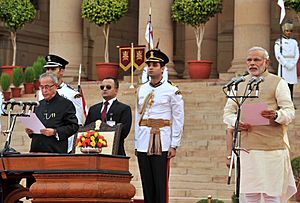
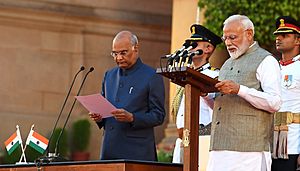
After the Bharatiya Janata Party led National Democratic Alliance won a landslide in the 2014 Lok Sabha election, Modi was sworn in as the Prime Minister of India on 26 May 2014. He became the first Prime Minister born after India's independence from the British Empire in 1947. Modi started his second term after the National Democratic Alliance won again in the 2019 Lok Sabha election. On 6 December 2020, Modi became the 4th longest serving Prime Minister of India and the longest serving Non-Congress Prime Minister.
Governance and other initiatives
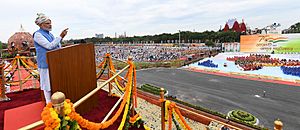
Modi's first year as prime minister saw significant centralisation of power. Initially lacking a majority in the Rajya Sabha, or upper house of Indian Parliament, Modi passed a number of ordinances to enact his policies, leading to further centralisation of power. The government also passed a bill increasing the control that it had over the appointment of judges, and reducing that of the judiciary. In December 2014 Modi abolished the Planning Commission, replacing it with the National Institution for Transforming India, or NITI Aayog. The move had the effect of concentrating the power previously with the planning commission in the person of the prime minister. The planning commission had received heavy criticism in previous years for creating inefficiency in the government, and of not filling its role of improving social welfare: however, since the economic liberalisation of the 1990s, it had been the major government body responsible for measures related to social justice.
The Modi government launched investigations by the Intelligence Bureau against numerous civil society organisations and foreign non-governmental organisations in the first year of the administration. The investigations, on the grounds that these organisations were slowing economic growth, was criticised as a witch-hunt. International humanitarian aid organisation Medecins Sans Frontieres was among the groups that were put under pressure. Other organisations affected included the Sierra Club and Avaaz. Cases of sedition were filed against individuals criticising the government. This led to discontent within the BJP regarding Modi's style of functioning and drew comparisons to the governing style of Indira Gandhi.
Modi repealed 1,200 obsolete laws in first three years as prime minister; a total of 1,301 such laws had been repealed by previous governments over a span of 64 years. Modi also launched the Digital India programme, with the goal of ensuring that government services are available electronically, building infrastructure to provide high-speed Internet access to rural areas, boosting manufacturing of electronic goods in the country, and promoting digital literacy.
In 2019, a law was passed to reserve 10% of educational admission and government jobs for economically disadvantaged individuals. The Indian government launched the Ujjwala scheme in 2016 to provide free LPG connections to rural households. The scheme led to an additional 24% of Indian households having access to LPG in 2019 as compared to 2014. In 2022, the government eliminated subsidies for LPG for all citizens except those covered by the Ujjwala program.
Hindutva
The activities of a number of Hindu nationalist organisations increased in scope after Modi's election as Prime Minister, sometimes with the support of the government. These activities included a Hindu religious conversion programme, a campaign against the alleged Islamic practice of "Love Jihad", and attempts to celebrate Nathuram Godse, the assassin of Mahatma Gandhi, by members of the right wing Hindu Mahasabha. Officials in the government, including the Home Minister, defended the conversion programmes.
Links between the BJP and the RSS grew stronger under Modi. The RSS provided organisational support to the BJP's electoral campaigns, while the Modi administration appointed a number of individuals affiliated with the RSS to prominent government positions. In 2014, Yellapragada Sudershan Rao, who had previously been associated with the RSS, became the chairperson of the Indian Council of Historical Research (ICHR). Historians and former members of the ICHR, including those sympathetic to the BJP, questioned his credentials as a historian, and stated that the appointment was part of an agenda of cultural nationalism. Over its first term the Modi administration appointed other RSS members to lead universities and research institutions, and recruitment of faculty members favoring the RSS increased. Scholars Nandini Sundar and Kiran Bhatty write that many of these appointees did not possess the qualifications for their positions. The Modi administration also made numerous changes in government-approved history textbooks. These changes de-emphasizing the role of Jawaharlal Nehru, and glorifying that of Modi himself, while also portraying Indian society as harmonious, without conflict or inequity.
The Modi administration passed a citizenship law in 2019 which provided a pathway to Indian citizenship for persecuted religious minorities from Afghanistan, Bangladesh and Pakistan who are Hindus, Sikhs, Buddhists, Jains, Parsis or Christians. The law does not grant such eligibility to Muslims. This was first time religion had been overtly used as a criterion for citizenship under Indian law: it attracted global criticism, and sparked widespread protests that were halted by the COVID-19 pandemic. Counter-demonstrations against the protests developed into the 2020 Delhi riots, caused chiefly by Hindu mobs attacking Muslims. Of the 53 people killed, two-thirds were Muslim. On 5 August 2020, Modi visited Ayodhya after the Supreme Court in 2019 ordered a contested land in Ayodhya to be handed over to a trust to build the Hindu temple and ordered the government to give alternate 5 acre land to Sunni Waqf Board for the purpose of building a mosque. He became the first prime minister to visit Ram Janmabhoomi and Hanuman Garhi.
Soon after Modi returned to power in 2019, he took three actions long called for by the RSS. The practice of Triple Talaq was made illegal, and a punishable act from 1 August 2019. The administration scrapped Article 370 of the Indian constitution, which granted autonomy to Jammu and Kashmir, and also abrogated its statehood, reorganizing it into two union territories, Jammu and Kashmir and Ladakh. The region was placed under a lockdown with internet services suspended: services were not completely restored until February 2021. Thousands of people, including hundreds of political leaders, were detained. The Supreme Court did not hear constitutional challenges to the reorganisation or the Citizenship Amendment Act: Bhatty and Sundar describe this as an example of the subversion of the Supreme Court and other major institutions, wherein they were filled with appointees favoring the BJP.
Economic policy
The economic policies of Modi's government focused on privatisation and liberalisation of the economy, based on a neoliberal framework. Modi liberalised India's foreign direct investment policies, allowing more foreign investment in several industries, including in defence and the railways. Other proposed reforms included making it harder for workers to form unions and easier for employers to hire and fire them; some of these proposals were dropped after protests. The reforms drew strong opposition from unions: on 2 September 2015, eleven of the country's largest unions went on strike, including one affiliated with the BJP. The Bharatiya Mazdoor Sangh, a constituent of the Sangh Parivar, stated that the underlying motivation of labour reforms favoured corporations over labourers.
The funds dedicated to poverty reduction programmes and social welfare measures were greatly decreased by the Modi administration. The money spent on social programmes declined from 14.6% of GDP during the Congress government to 12.6% during Modi's first year in office, while spending on health and family welfare declined by 15%. The government also lowered corporate taxes, abolished the wealth tax, increased sales taxes, and reduced customs duties on gold, and jewellery. In October 2014, the Modi government deregulated diesel prices. Over Modi's first term, the government reduced spending on education as share of the budget: over five years, education spending dropped from 0.7% of GDP to 0.5%. The percentage of the budget spent on children's nutrition, education, health, and associated programs was reduced by nearly half by the Modi administration between 2014 and 2022.
In September 2014, Modi introduced the Make in India initiative to encourage foreign companies to manufacture products in India, with the goal of turning the country into a global manufacturing hub. Supporters of economic liberalisation supported the initiative, while critics argued it would allow foreign corporations to capture a greater share of the Indian market. Modi's administration passed a land-reform bill that allowed it to acquire private agricultural land without conducting a social impact assessment, and without the consent of the farmers who owned it. The bill was passed via an executive order after it faced opposition in parliament, but was eventually allowed to lapse. Modi's government put in place the Goods and Services Tax, the biggest tax reform in the country since independence. It subsumed around 17 different taxes and became effective from 1 July 2017.
In his first cabinet decision, Modi set up a team to investigate black money. On 9 November 2016, the government demonetised ₹500 and ₹1000 banknotes, with the stated intention of curbing corruption, black money, the use of counterfeit currency, and terrorism. The move led to severe cash shortages, a steep decline in the Indian stock indices BSE SENSEX and NIFTY 50, and sparked widespread protests throughout the country. Several deaths were linked to the rush to exchange cash. In the subsequent year, the number of income tax returns filed for individuals rose by 25%, and the number of digital transactions increased steeply.
Over the first four years of Modi's premiership, India's GDP grew at an average rate of 7.23%, higher than the rate of 6.39% under the previous government. The level of income inequality increased, while an internal government report said that in 2017, unemployment had increased to its highest level in 45 years. The loss of jobs was attributed to the 2016 demonetisation, and to the effects of the Goods and Services Tax. GDP growth was 6.12% in the 2018–19 FY, with an inflation rate of 3.4%. In the year 2019–20, the GDP growth rate slowed to 4.18%, while inflation increased to 4.7%. The Indian economy shrunk by 6.6% during the COVID-19 pandemic in 2020-2021, and was estimated to grow at 8.2% the following financial year.
Health and sanitation
In his first year as prime minister, Modi reduced the amount of money spent by the central government on healthcare. The Modi government launched New Health Policy (NHP) in January 2015. The policy did not increase the government's spending on healthcare, instead emphasising the role of private healthcare organisations. This represented a shift away from the policy of the previous Congress government, which had supported programmes to assist public health goals, including reducing child and maternal mortality rates. The National Health Mission, which included public health programmes targeted at these indices received nearly 20% less funds in 2015 than in the previous year. The Modi administration reduced the healthcare budget by a further 15% in its second year. The healthcare budget for the following year rose by 19%. The budget was viewed positively by private insurance providers. Public health experts criticised its emphasis on the role of private healthcare providers, and suggested that it represented a shift away from public health facilities. The healthcare budget rose by 11.5% in 2018; the change included an allocation of ₹20 billion (US$340 million) for a government-funded health insurance program, and a decrease in the budget of the National Health Mission.
Modi emphasised his government's efforts at sanitation as a means of ensuring good health. On 2 October 2014, Modi launched the Swachh Bharat Mission ("Clean India") campaign. The stated goals of the campaign included eliminating manual scavenging within five years. As part of the programme, the Indian government began constructing millions of toilets in rural areas and encouraging people to use them. The government also announced plans to build new sewage treatment plants. The administration plans to construct 60 million toilets by 2019. The construction projects have faced allegations of corruption, and have faced severe difficulty in getting people to use the toilets constructed for them. Sanitation cover in the country increased from 38.7% in October 2014 to 84.1% in May 2018; however, usage of the new sanitary facilities lagged behind the government's targets. In 2018, the World Health Organization stated that at least 180,000 diarrhoeal deaths were averted in rural India after the launch of the sanitation effort.
In response to the COVID-19 pandemic, the Modi administration invoked the Epidemic Diseases Act, 1897 and Disaster Management Act, 2005 in March 2020. All commercial domestic and international flights were suspended in March. Modi announced a 14 hour curfew on 22 March, followed by a three-week "total lockdown" two days later. Restrictions were gradually lifted beginning in April, and were completely revoked in November 2020. A second wave of the pandemic began in March 2021 was much more devastating than the first, with shortages of vaccines, hospital beds, oxygen cylinders and other medical supplies in parts of the country. In late April India reported over 400,000 cases in a 24-hour period, the first country to do so. India began its vaccination programme in January 2021; in January 2022, India announced that it administered about 1.7 billion doses of vaccines and more than 720 million people were fully vaccinated. In May 2022, the World Health Organization estimated that 4.7 million Indians had died of Covid-19 in India, mostly during the second wave in mid-2021. The figure was almost 10 times the Indian government's estimate. The Modi administration rejected the estimate.
Foreign policy
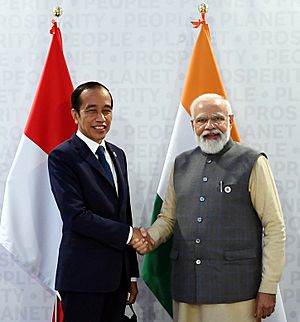
Foreign policy played a small role in Modi's election campaign, and did not feature prominently in the BJP's election manifesto. Modi's foreign policy, similarly to that of the preceding Congress government, focused on improving economic ties, security, and regional relations. Modi continued Manmohan Singh's policy of "multi-alignment." The Modi administration tried to attract foreign investment in the Indian economy from several sources, especially in East Asia, with the use of slogans such as "Make in India" and "Digital India". The government also tried to improve relations with Islamic nations in the Middle East, such as Bahrain, Iran, Saudi Arabia, and the United Arab Emirates, as well as with Israel.
The foreign relations of India with the USA also mended after Narendra Modi became the Prime Minister. During the run-up to the general election there was wide-ranging scepticism regarding future of the strategic bilateral relation under Modi's premiership as in 2005 he was, while Chief Minister of Gujarat, denied a U.S. visa during the Bush administration for his poor human rights records. However sensing Modi's inevitable victory well before the election, the US Ambassador Nancy Powell had reached out to him as part of greater rapprochement from the west. Moreover, following his 2014 election as the Prime Minister of India, President Obama congratulated him over the telephone and invited him to visit the US. The Modi government was successful in forging good foreign relations with the USA in the presidencies of both Barack Obama and Donald Trump.
During the first few months after the election, Modi made trips to a number of different countries to further the goals of his policy, and attended the BRICS, ASEAN, and G20 summits. One of Modi's first visits as prime minister was to Nepal, during which he promised a billion USD in aid. Modi also made several overtures to the United States, including multiple visits to that country. While this was described as an unexpected development, due to the US having previously denied Modi a travel visa over his role during the 2002 Gujarat riots, the visits were expected to strengthen diplomatic and trade relations between the two countries.
In 2015, the Indian parliament ratified a land exchange deal with Bangladesh about the India–Bangladesh enclaves, which had been initiated by the government of Manmohan Singh. Modi's administration gave renewed attention to India's "Look East Policy", instituted in 1991. The policy was renamed the "Act East Policy", and involved directing Indian foreign policy towards East Asia and Southeast Asia. The government signed agreements to improve land connectivity with Myanmar, through the state of Manipur. This represented a break with India's historic engagement with Myanmar, which prioritised border security over trade. China–India relations have deteriorated rapidly following the 2020 China–India skirmishes. Modi has pledged aid of $900 million to Afghanistan, visited the nation twice and been honoured with the nation's highest civilian honour in 2016.
Defence policy
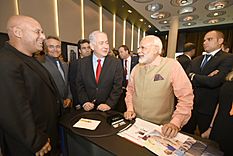
India's nominal military spending increased steadily under Modi. The military budget declined over Modi's tenure both as a fraction of GDP and when adjusted for inflation. A substantial portion of the military budget was devoted to personnel costs, leading commentators to write that the budget was constraining Indian military modernisation.
Modi promised to be "tough on Pakistan" during his election campaign, and repeatedly stated that Pakistan was an exporter of terrorism. In February 2019, India carried out airstrikes in Pakistan against a supposed terrorist camp. Further military skirmishes followed, including cross-border shelling and the loss of an Indian aircraft.
Following his victory in 2019 Lok Sabha elections, he focused more on Defence policies of India, especially against China and Pakistan. On 5 May 2020, Chinese and Indian troops engaged in aggressive melee, face-offs and skirmishes at locations along the Sino-Indian border, including near the disputed Pangong Lake in Ladakh and the Tibet Autonomous Region, and near the border between Sikkim and the Tibet Autonomous Region. Additional clashes also took place at locations in eastern Ladakh along the Line of Actual Control (LAC). After which there was start of skirmishes between the nations leading to many border clashes, responses and reactions from both sides. A series of talks were also held between the two by both military and diplomatic means for peace. The first border clash reported in 2021 was on 20 January, referred to as a minor border clash in Sikkim.
Modi signed an agreement with Russian leader Vladimir Putin in December 2021 to extend military technical cooperation. The Modi government struck a deal with Russia, buying the S-400 missile system, an anti-missile striking system thereby constructing much stronger ties and relationship between the two nations.
Environmental policy
In naming his cabinet, Modi renamed the "Ministry of Environment and Forests" the "Ministry of Environment, Forests, and Climate Change." In his administration's first budget, the money allotted to this ministry was reduced by more than 50%. The new ministry removed or diluted a number of laws related to environmental protection, and others related to industrial activity. The government also tried to reconstitute the National Board for Wildlife such that it no longer had representatives from non-governmental organisations: however, this move was prevented by the Supreme Court. Other changes included reducing ministry oversight on small mining projects, and no longer requiring approval from tribal councils for projects inside forested areas. In addition, Modi lifted a moratorium on new industrial activity in the most polluted areas in the countries. The changes were welcomed by businesspeople, but criticised by environmentalists.
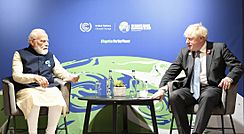
Speaking with Assamese students in 2014, Modi downplayed climate change, saying "Climate has not changed. We have changed. Our habits have changed. Our habits have got spoiled. Due to that, we have destroyed our entire environment." However, over the years he has been vocal for climate action, especially with proliferating clean energy. Modi in 2015 proposed the International Solar Alliance initiative to encourage investment into solar energy. Holding developed countries responsible, Modi and his government have multiple times reiterated that India has negligible role in climate change historically. At the COP26 conference Modi announced that India would target carbon neutrality by 2070, and also expand its renewable energy capacity. Indian environmentalists and economists applauded the decision, describing it as a bold climate action. India has emerged as the only major economy to be on track to meet Paris Agreement goals. It has achieved 10% ethanol blending five months ahead of schedule.
Democratic backsliding
Under Modi's tenure, India has experienced democratic backsliding. According to one study, "The BJP government incrementally but systemically attacked nearly all existing mechanisms that are in place to hold the political executive to account, either by ensuring that these mechanisms became subservient to the political executive or were captured by party loyalists." Scholars also point to how the Modi government has used state power to intimidate and stifle critics in the media and academia, thus undermining freedom of expression and alternative sources of information. There have been several reports of the Modi government to be as an authoritarian conservative government, even due to lack of good opposition.
Public perception and image
Modi has received consistently high approval ratings during his tenure; he is often ranked in popular opinion polls as the greatest prime minister in Indian history.
Awards and recognition
In March 2012 and June 2014, Modi appeared on the cover of the Asian edition of Time Magazine, one of the few Indian politicians to have done so. He was awarded Indian of the Year by CNN-News18 (formally CNN-IBN) news network in 2014. In June 2015, Modi was featured on the cover of Time Magazine. In 2014, 2015, 2017, 2020 and 2021, he was named one of Time magazine's 100 Most Influential People in the World. Forbes Magazine ranked him the 15th Most Powerful Person in the World in 2014 and the 9th Most Powerful Person in the World in 2015, 2016 and 2018. In 2015, Modi was ranked the 13th Most Influential Person in the World by Bloomberg Markets Magazine. In 2021 Time called him the third "pivotal leader" of independent India after Jawaharlal Nehru and Indira Gandhi who "dominated the country's politics like no one since them". Modi was ranked fifth on Fortune Magazine's first annual list of the "World's Greatest Leaders" in 2015. In 2017, Gallup International Association (GIA) conducted a poll and ranked Modi as third top leader of the world. In 2016, a wax statue of Modi was unveiled at Madame Tussauds wax museum in London.
In 2015 he was named one of Time's "30 Most Influential People on the Internet" as the second-most-followed politician on Twitter and Facebook. In 2018, he was the third most followed world leader on Twitter, and the most followed world leader on Facebook and Instagram. In October 2018, Modi received United Nations's highest environmental award, the 'Champions of the Earth', for policy leadership by "pioneering work in championing" the International Solar Alliance and "new areas of levels of cooperation on environmental action". He was conferred the 2018 Seoul Peace Prize in recognition of "his dedication to improving international co-operation, raising global economic growth, accelerating the Human Development of the people of India by fostering economic growth and furthering the development of democracy through anti-corruption and social integration efforts". He is the first Indian to win the award.
Following his second swearing-in ceremony as Prime Minister of India, a picture of Modi was displayed on the facade of the ADNOC building in Abu Dhabi, United Arab Emirates. The Texas India Forum hosted a community event in honour of Modi on 22 September 2019 at the NRG Stadium in Houston, Texas. The event was attended by over 50,000 people and several American politicians including President Donald Trump, making it the largest gathering for an invited foreign leader visiting the United States other than the Pope. At the same event, Modi was presented with the Key to the City of Houston by Mayor Sylvester Turner. He was awarded the Global Goalkeeper Award on 24 September 2019 in New York City by the Bill & Melinda Gates Foundation in recognition for the Swachh Bharat Mission and "the progress India has made in providing safe sanitation under his leadership".
In 2020, Modi was among eight world leaders awarded the parodic Ig Nobel Prize in Medical Education "for using the COVID-19 viral pandemic to teach the world that politicians can have a more immediate effect on life and death than scientists and doctors can". On 21 December 2020, President Donald Trump awarded Modi with the Legion of Merit for elevating the India–United States relations. The Legion of Merit was awarded to Modi along with Prime Minister of Australia Scott Morrison and former Prime Minister of Japan Shinzo Abe, the "original architects" of the QUAD. On 24 February 2021, the largest cricket stadium in the world at Ahmedabad was renamed Narendra Modi Stadium by the Gujarat Cricket Association.
In July 2024, during a visit to Russia, Modi was awarded the Order of St. Andrew, Russia's highest civilian award, for his effort in the development of the bilateral ties between India and Russia. Later in November 2024, during a diplomatic visit to Nigeria, Modi was conferred the Grand Commander of the Order of the Niger (GCON) by the Nigerian President. This is one of the country's highest honours, making him the second foreign dignitary to receive the award, after Queen Elizabeth II in 1969. President Bola Tinubu stated that the award was presented in recognition of Nigeria's appreciation for the growing partnership between the two countries. Upon his arrival, Modi was presented with the symbolic "Key to the City" of Abuja by Minister Nyesom Wike, a gesture symbolising trust and honour from the people of Nigeria. In December 2024, Modi was conferred the Order of Mubarak the Great, the highest national honor of Kuwait.
Electoral history
| Year | Office | Constituency | Party | Votes for Modi | % | Opponent | Party | Votes | % | Margin | Result | Ref | ||
|---|---|---|---|---|---|---|---|---|---|---|---|---|---|---|
| 2002^ | Member of the Legislative Assembly | Rajkot II | Bharatiya Janata Party | 45,298 | 57.32 | Ashwinbhai Narbheshankar Mehta | Indian National Congress | 30,570 | 38.68 | 14,728 | Won | |||
| 2002 | Maninagar | 113,589 | 73.29 | Yatinbhai Oza | 38,256 | 24.68 | 75,333 | Won | ||||||
| 2007 | 139,568 | 69.53 | Dinsha Patel | 52,407 | 26.11 | 87,161 | Won | |||||||
| 2012 | 120,470 | 75.38 | Shweta Sanjiv Bhat | 34,097 | 21.34 | 86,373 | Won | |||||||
| 2014 | Member of Parliament, Lok Sabha | Vadodara | 845,464 | 72.75 | Madhusudan Mistry | 275,336 | 23.69 | 570,128 | Won | |||||
| 2014 | Varanasi | 581,022 | 56.37 | Arvind Kejriwal | Aam Aadmi Party | 209,238 | 20.30 | 371,784 | Won | |||||
| 2019 | 674,664 | 63.62 | Shalini Yadav | Samajwadi Party | 195,159 | 18.40 | 479,505 | Won | ||||||
| 2024 | 612,970 | 54.24 | Ajay Rai | Indian National Congress | 460,457 | 40.74 | 152,513 | Won | ||||||
See also
 In Spanish: Narendra Modi para niños
In Spanish: Narendra Modi para niños


